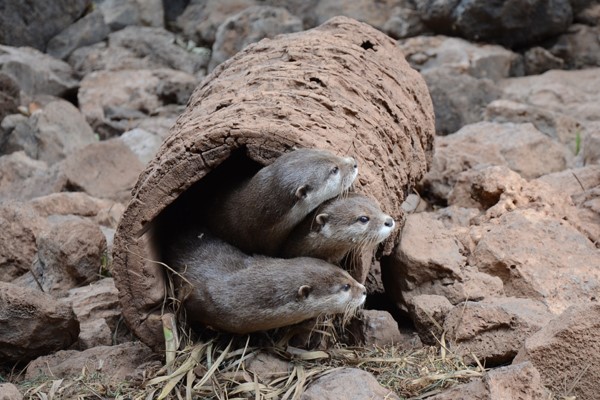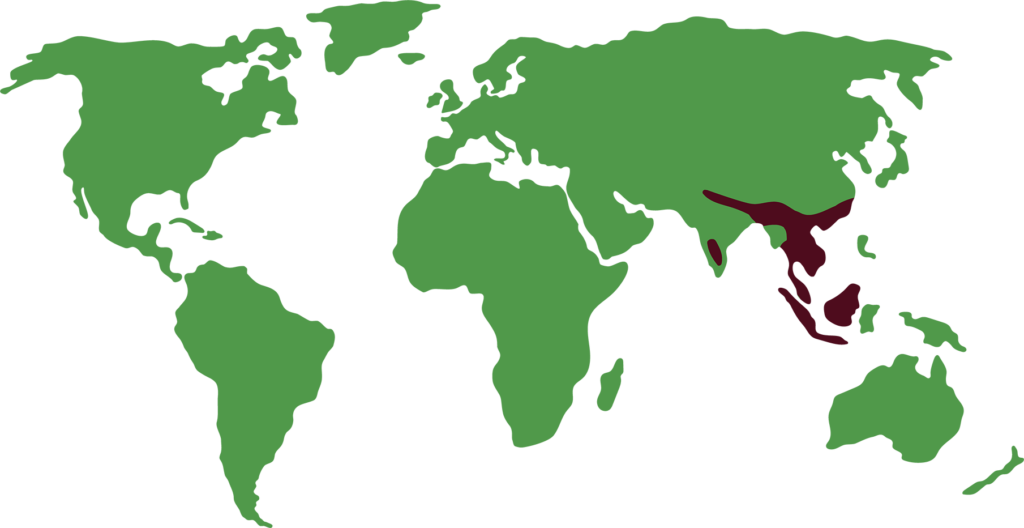ASIAN SMALL-CLAWED OTTER
Aonyx cinereus

LENGTH

1 m
WEIGHT

5 kg
LIFESPAN

10 years
The Asian small-clawed otter is a species of carnivorous mammal of the family Mustelidae native to Southeast Asia. These otters are noted for their waterproof fur, which allows them to live in aquatic habitats, and their underwater hunting abilities.
General characteristics
It is the smallest otter species in existence, its total length can vary between 70 and 100 cm, of which about 30 cm is the tail. The fur is dark brown with a reddish tinge on the back. On the ventral surface it is lighter coloured, especially on the face and neck.
Otter´s body are slender, streamlined and flexible enough to allow grooming of almost the entire body. They have relatively short hairs (less than 2.5 cm in length) and their fur is made up of two layers: an outer layer with longer, sturdier hair that repels water, and an inner layer with short, fine hair that acts as insulation.
The claws are short and erect, not extending beyond the tips of its webbed toes. The tail is thick and muscular, especially at the base.
Feeding
Its diet varies according to the season. It feeds mainly on crabs, mudskippers and fish. When and where available, it also catches snakes, frogs, insects and rats.
Behaviour
These animals are most active after dusk. They live in groups of up to 15 individuals. Group members communicate through 12 or more distinct calls and emit a variety of howls and moans. When disturbed, they call out to others for help.
They are semi-aquatic and spend most of their time in the water. When swimming on the surface of the water, otters use their limbs to paddle. And when they dive underwater, they undulate their bodies and tails. They use grassy or sandy banks for resting, sun bathing and grooming
Reproduction
Otter´s form monogamous pairs and their mode of reproduction is viviparous. The estrous cycle of females lasts 28 to 30 days and oestrus lasts between 1 and 13 days. Mating usually takes place in the water.
Gestation lasts 62 to 86 days and each litter has between one and seven pups.
Approximately two weeks before birth, both the female and the male are engaged in building a nest using grass, hay or straw. The cubs are born with their eyes closed and open them in the fifth week. They become independent at around four to five months.
Threats
The Asian small-clawed otter population is declining due to habitat destruction related to agricultural development, deforestation and water pollution.
On the other hand, this species is also threatened by poaching for its fur. It is the most sought-after otter species for the illegal pet trade.
Distribution
The native range of the Asian small-clawed otter includes parts of India to Southeast Asia, including the islands of Sumatra, Java, Borneo and Palawan.
They live in freshwater wetlands such as marshes, meandering rivers, irrigated rice fields, as well as estuaries, coastal lagoons and tidal pools. They can also be found in shallow mountain streams up to an altitude of 2000 metres.

Did you know?
Otters are known for their meticulous grooming habits. They often groom themselves and each other, which helps to maintain the insulating properties of their fur.
They can use tools such as stones or other hard objects to break open shells of molluscs or crustaceans.
They are incredibly agile in the water. They can swim both forwards and backwards.
Conservation status
